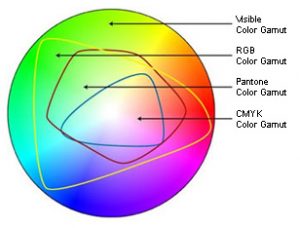Not every colour that can be expressed in L*a*b* can be reproduced in either the RGB ranges or “gamut” or as CMYK. This illustration can help to illustrate where the reproducible colour ranges fall:
The L*a*b* colour space provides coordinates for ALL visible colours, not all of which can be reproduced in other colour spaces. In the illustration shown here, even RGB can’t plot every colour in the visible spectrum and CMYK is the smallest subset of all of the color spaces. Custom-mixed inks, depending on the pigments, are much more flexible but it may not be possible to reproduce on an actual device.
Extended gamut printing goes much farther than ordinary CMYK by using technology to add standards-defined Orange, Green and Violet inks to print with seven colours. So, a deep Reflex Blue that would be impossible for CMYK alone has Violet added to extend the offset or digital printing process. This makes possible the printing of spot colours without having to custom-mix a Pantone colour. It’s also possible to formulate out of CMYK+OGV custom “brand” colours to match specific targets. While this process isn’t suitable for every customer’s needs, it can be a very cost-effective alternative to multiple spot colours. CMYK+OGV techniques can reproduce from 91% to 95% of the Pantone Matching System, within a variance of as little as .08 delta E to as much as 5 delta E, which is the difference between the target colour and the reproduced colour.
For cosmetics clients that are looking to represent skin tones across media, we probably have a reasonable chance of locating the colours in question within a CMYK space and representing those colours fairly in RGB. Since web and print viewing conditions and technology are completely different, direct “matches” between CMYK and RGB are not likely, though it will probably be close enough for practical use as long as it’s disclaimed as such.



